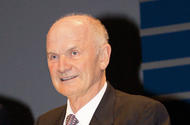Man behind landmark cars like the Porsche 917, Audi Quattro and Bugatti Veyron has died. Andrew Frankel looks back on his legacy
Ferdinand Piech once wrote ‘My desire for harmony is limited’, and if you look at his professional life and the reputations of all those executives that failed to survive close encounters with this most autocratic of engineers, you can see he wasn’t kidding.
In his private life he fathered 12 children by four different women, which is perhaps also indicative of the fact that Piech was not like other men.
Piech was a man who combined the obsessional engineering focus of a Colin Chapman with the commercial nous and global perspective of a Henry Ford. The turnaround in VW’s fortunes that he oversaw following his arrival there in 1993 almost beggars belief.
He inherited a group just weeks from bankruptcy, and left it in 2015 as the largest automotive car company on earth, acquiring some of the world’s most coveted name plates – Bentley, Bugatti and Lamborghini – along the way. And, of course Porsche.
Former VW Group boss Ferdinand Piech dies
He may not have had the surname, but Piech was as a much a Porsche as his grandfather Ferdinand or uncle Ferry. His influence at the company began as soon as he joined in 1963 clutching his engineering degree from the University of Zurich. He didn’t like the fact that the company’s new flat six engine designed for the as yet unlaunched 901 (which would become the 911) had a wet sump for it, meaning the motor would never be suited for racing. Such was the power of the family connection, he simply had it redesigned, a process that took six months, and 911s have raced ever since.
His obsession with racing and conviction that success on track could only come from ultra-lightweight techniques led to some of the most extraordinary innovations seen in motorsport. The 1968 909 Bergspyder hillclimb car weighed just 385kg, thanks to the fitment of titanium springs, a wiring loom made from silver thread and brakes made from beryllium – despite their dust coming in the same toxin category as asbestos, plutonium and mustard gas.
But it was the 917 of 1969 that was his masterpiece, not just because it was the fastest sports racing car the world had ever known, but for the circumstances surrounding its creation. New rules designed specifically to ensure that such a car never got built mandated that 25 must be shown before even one of them could race. In the past you might expect construct a handful at most, and then only over time. It was Piech who through sheer force of character convinced the board to spend the money to make the cars, arguing its superiority would ensure all and more would be recovered from sales to private teams.
The cars were built in record time and duly shown to the FIA’s dumbfounded delegate on April 1st 1969, Piech even offering to let him drive one to show this was no smoke and mirrors trick. The car was homologated on May 1st and raced for the first time just ten days later. Porsche has now been dining out on the legend of the 917 for fully half a century.
But Piech was responsible for so much more. Moving to Audi in the 1970s, he was responsible for the new 100 being the world’s most aerodynamically efficient production car and for its then unique five cylinder engine. But that was just the start: his most famous achievement there was the creation of the Quattro, a car that transformed Audi’s reputation on both the public road and special stage, and whose 40th anniversary will be celebrated next year.
Platform engineering was not new when he turned up at VW in 1993, but he took to an entirely new level, essentially creating one car and giving it different outfits for different manufacturers. Years ago I did a story for Autocar where I gathered a VW Golf, an Audi A3, a Skoda Octavia and Seat Leon all powered by the same engine, opened their bonnets and tried to find a single clip, hose, nut, bolt or washer not common to all. I failed.
Piech could fail too, but even those cars of his that didn’t work and lost VW heroic amounts of money all failed not because they were not good enough, but because they were so good an irrecoverable amount of money had been spent in their creation. The most notable examples were making the small Audi A2 out of aluminium, building the VW Phaeton to standards good enough for Bentley and creating the financial mineshaft down which the heinously expensive-to-develop Bugatti Veyron fell.
Piech was a man who fought to the last. Probably the greatest achievement of his life in business was not only fending off an aggressive takeover bid of VW from his old family firm of Porsche, but turning the tables so comprehensively that VW ended up acquiring Porsche.
His last battle was with VW CEO Martin Winterkorn which resulted in a ‘him or me’ showdown with the Supervisory Board. To the great surprise of many, VW backed Winterkorn and, in 2015, Piech was gone. But later that same year, Winterkorn himself was forced out as the Dieselgate scandal suddenly broke the surface.
If things were bad for Winterkorn then, they were about to get a whole lot worse: in 2017, Der Spiegel reported that Piech had told the investigating authorities that Winterkorn had known about the ‘defeat device’ being fitted to VW engines long before it had become public knowledge.
In 2018 criminal charges were filed against Winterkorn in the US and in Germany earlier this year. Piech’s reaction to the news was not recorded, but can perhaps be imagined.
Read more
Quattro: the car that made Audi
Bugatti Veyron 2005-2015 review
History of the Volkswagen Golf – picture special
Source: Autocar
